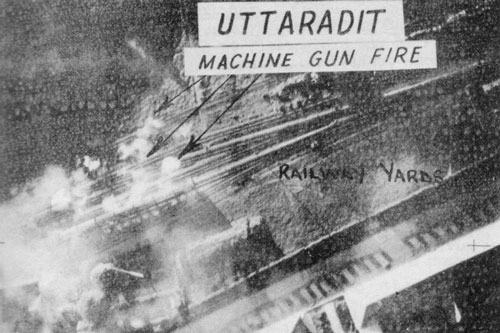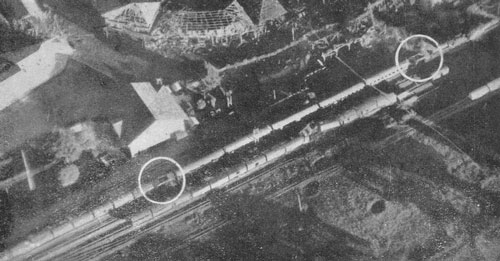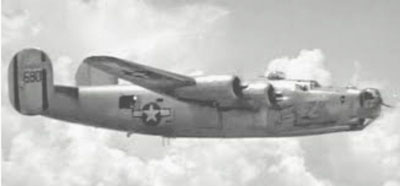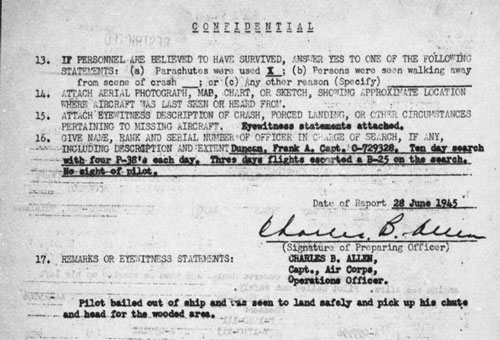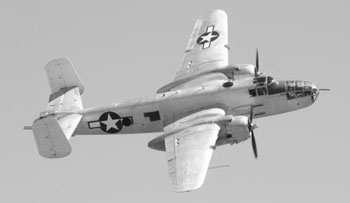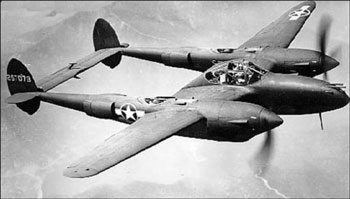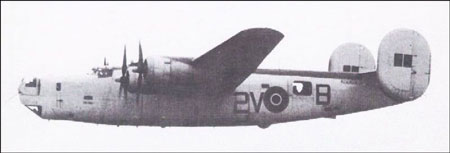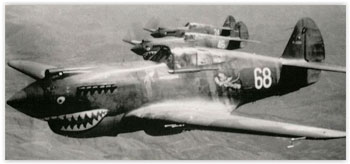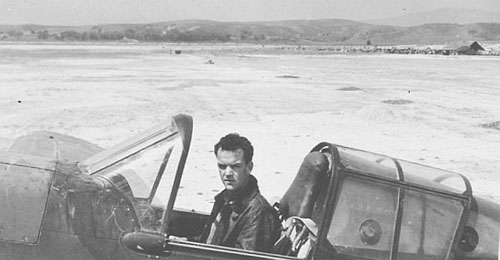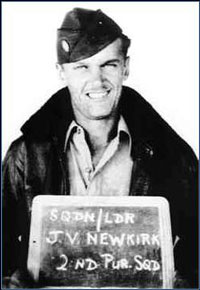06 Oct 1944:1 Note that this loss was one of three by the RAF this date on this mission, and individual details of the three have been sometimes difficult to differentiate. The three losses were BZ978, BZ992, and EV940. A Liberator B.VI 2 with the designation EV940 was homebased with Squadron 355 at Salbani Airfield, India 3(N22°36.74 E87°17.88):4
 And on or about this date, it participated in a 16 bomber raid on the Thai railway north of Bangkok.5
And on or about this date, it participated in a 16 bomber raid on the Thai railway north of Bangkok.5
 At “Uttaradit Railyard” (rail stationing 485+170: N17°37.2 E100°05.8), the heavy bomber made a low level strafing run on locomotives. The plane was seen by another in the flight to have been hit by anti-aircraft fire and it eventually crashed at N17°25 E100°05, 6 about 23km south of the railyard. Two crewmembers survived to be taken prisoner while nine were killed in the crash: 7
At “Uttaradit Railyard” (rail stationing 485+170: N17°37.2 E100°05.8), the heavy bomber made a low level strafing run on locomotives. The plane was seen by another in the flight to have been hit by anti-aircraft fire and it eventually crashed at N17°25 E100°05, 6 about 23km south of the railyard. Two crewmembers survived to be taken prisoner while nine were killed in the crash: 7
Survivors:
Raymond Arthur Thompson (3025036)
FH Knight (1603067)Casualties: Remains were recovered and buried in Kanchanaburi War Cemetery Collective Grave 4.G.67-75:
Thomas AISBITT (3040082)
Murray Bernard CROCKETT (410876)
Alfred Milne Hunter DAVIDSON (421713)
Harold Norman HARRISON (1575095)
Harry LAW (1579345)
Hugh Cecil MARTIN (1796212)
Charles NUNN (1320361)
Roy PAGE (996520)
John Knox Stewart RADNIDGE (421757)
Aerial photos from that date illustrate possible sources of the ground fire which brought down EV940.8 Machine gun fire from the railway yard:
And two flak wagons, located in a string of rail cars (carriages):
Credit for the shootdown of EV940 was given to a gunner firing from one of the flak wagons: Capt Bantao Punsri. He had, in fact, redesigned the gun sight and modified the mountings for weapons on Thai Railway flak wagons. 9
To put the photos in proper context, the fields of view of the photos above are superimposed on an extract from a later photo of Uttaradit town showing the railway yard: 10
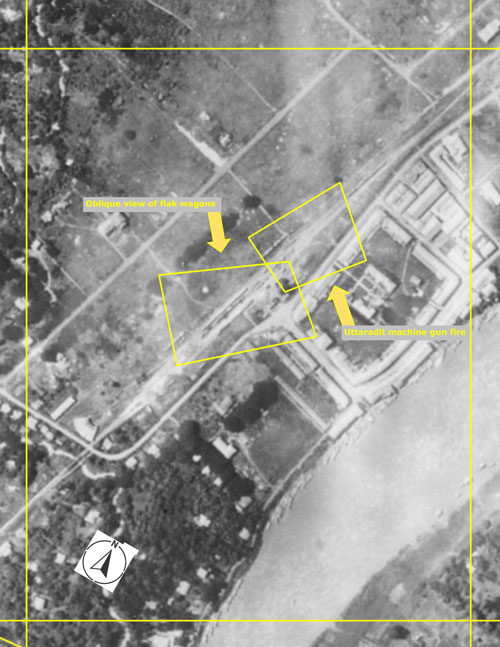 And the fields of view superimposed on a macro view of the town: 11
And the fields of view superimposed on a macro view of the town: 11
Uttaradit Municipal buildings now occupy the land once identified as a POW Camp.
The wreckage of EV940 can be assumed to have eventually found its way into a Japanese scrap metal drive. 12
References:
• Allied Eastern Air Command Weekly Intelligence Summary, 13 Oct 1944: 13
Section I. Resume of Enemy Operations, p 7:
6 Oct – [No entry this date for shootdown of EV940 or on 7 Oct (see below)]
Section V. AA Fire Encountered-Week Ending 08 October 1944,
p 4 [and see Captain Bantao Punsri, directly below]:Date: 6/10 14
Time: –
Place: UTTARADIT
Type: [Machine Gun] & [Light Anti-Aircraft Gun] Height: 300
Accuracy: Acc.
Intensity: –
Reported by: 355 & 356 Sq Libs
Remarks and Comments: From station area. One a/c burst into flames and crashed
• Captain Bantao Punsri, Royal Thai Army 15
Translation: Later Allied aircraft were attacking bridges, especially the one at Ban Dara, on the railway to the north. I was put in charge of installing anti-aircraft guns on the train and at the foot of Ban Dara bridge. The one on the train had a tripod mount which made it difficult to swivel round; so I got permission to change the tripod stand to a monopod so that I could turn the gun round when I shot. It worked so well that I shot a B-24 down at Uttaradit, and the gun at Ban Dara shot down another B-24. We took two prisoners at Uttaradit and five from Ban Dara; 15 were killed. [page 69]
His wife added details:
Translation: Khun Bantao told me long ago that he had thought about how to improve a gun sight. He wanted it to be larger so that he could see a target more clearly: the one originally provided with the gun was a small square sight and he developed a larger oval one to replace it using rod from an umbrella frame. He told me about the number of prisoners and deaths from aircraft that had been shot down. He informed his commander in a telegram (which a kind soldier showed me so that I didn’t need to worry about my husband) that he suspected two more aircraft had been shot down because he saw them leaving the target trailing flames. He learned later that he was right: one had been shot down at the border and another went down in the sea. [page 71]
Comments:
•The two B-24s, EV940 (here) and BZ992 (over Ban Dara bridge) were clearly brought down by ground fire, presumably faciliated by Bantao’s innovation.
• The one that went down in the sea might well have been BZ978, also a possible victim (delayed) of ground fire, though not named in messages from BZ978 before it ditched (Umemoto doesn’t commit to an identity for the “Shooter” of BZ978, leaving it to a Ki-43 or AA fire).
• But the aircraft shot down at the border is an unknown.
• Ozel, Thai Air Accidents, pp 2, 3:
The aircraft was making a low bombing attack on two locomotives at Uttaradit station on the Bangkok-Lampang railway line. The formation attacked in line astern, diving from 1500 to 300 feet. One of the aircraft in the formation reported seeing tracers from a machine-gun nest going into EV940 and that the aircraft steepened its climbing turn to 90° and slipped inwards out of control, crashing at 17.419972°, 100.079997°, near Uttaradit. The aircraft blew up on impact, killing 9 of the 11 on board (Sgt. Thomas Aisbitt, Wt. Off. Murray Bernard Crockett, Wt. Off. Alfred Milne Hunter Davidson Flt. Sgt. Harold Norman Harrison, Sgt. Harry Law, Sgt. Hugh Cecil Martin, Flt. Sgt. Charles Nunn, Flt. Sgt. Roy Page & Wt. Off. John Knox Stewart Radnidge); 2 (Sgt. G. A. Thompson & Sgt. N. H. Knight) survived as POW’s.
Comment: This would indicate that 355 Squadron aircraft had been heading south during their attack on the railyard, whereas the Royal Air Force recorded the crash as north of the target which would suggest the attack had come from the opposite direction. Heading south as presented by Ozel is supported by “Circumstantial Report on Liberator ‘W’ 978” as explained in BZ978 footnote 10.
• Royal Air Force Commands: Liberator EV940:
Liberator EV940
Aircraft Accident / Loss Entry
Date of Crash: 06 Oct 44
Aircraft name: Liberator VI
Serial Number: EV940
Unit: 355 SqdnDetails: Low-level dive bombing attack on locomotives in the Uttaradit rail station, Siam. EV940 pulled up sharply after dropping bombs across the target and was hit by fire from a machine gun nest just beyond the target. Crashed in flames 7 to 8 km north (or northwest) of the target. Of the eleven man crew, nine were killed in the aerial combat or crash, including the skipper, 1575095 F/Sgt Harold Norman “Darky” Harrison. They are buried in Collective Grave 4.G.67-75 at Kanchanaburi War Cemetery, Thailand. Three crewmen bailed out, but one died when his parachute failed to open. The two others were captured, imprisoned in Bangkok, and liberated in 1945. They are 3025036 Sgt Raymond Arthur Thompson (Mid-upper gunner) and 1603067 Sgt F.H. Knight (Rear gunner).
• Shores, 2005 16
Saturday, 07 October 1944
During the last minute of the previous day, 16 Liberators of 159 Squadron took off for a raid on the railway north of Bangkok at low level; they were joined by eight more bombers from 355 and 356 Squadrons. . . .
204th Sentai pilots claimed another Liberator near Bangkok, and yet another was claimed by AA crews. . . . One of these aircraft was a 355 Squadron machine, which was reported shot down over the target and which crashed in a wood eight kilometres from the railway target when attacked by a lone Ki-43.
Comments:
• The date is incorrect per review in footnote 1.
• An attack by a Ki-43 may have occurred, but an eye witness from another aircraft on the mission saw EV940 fatally struck by ground fire (see Royal Air Force Commands excerpts above).
• Umemoto, 2002: 17
| 06 Oct 1944 | ||
| 355 Squadron | ||
| B-24 Heavy Bomber | ||
| Master Sergeant HN Harrison | ||
| Between Bangkok and Chiang Mai | ||
| 204th Sentai: Ki-43 II | ||
| 1 prisoner of war. 8 killed in action | ||
Umemoto text: 18
午後、8機で、同じくバンコク、チェンマイ間の鉄道攻撃に赴いた第355飛行隊、ハリスン曹長 のB24も、ゥッタラディト駅付近で、日本戦闘機1機の攻撃を受け、目標上空で被弾、目標から約8キ ロ離れた地点の森に墜落、爆発、射手のトンプスン軍曹だけが墜落から生き残り捕虜になった。このリ ベレーターと交戦したのも、当時、タイのドムアン飛行場にいた204戦隊の一式戦と思われるが、日 本側による詳細な記録は見あたらない。64戦隊の宮邊大尉は、雨季明け後、ドムアンに来襲した連合軍 機の邀撃には第1中隊の中村大尉らが指導したタイ空軍の一式戦も参加「敵機と堂々と渡り合った」と している。もしかすると、ハリスン曹長のB24を撃墜したのはタイ空軍機だったのかもしれない。
In the afternoon [of 06 October 1944], the 355th Squadron, Master Sergeant Harrison’s B-24 participated in attacking targets on the railrway between Bangkok and Chiang Mai as part of a group of eight aircraft. They were, in turn, attacked by a Japanese fighter near Uttaradit Station and EV940 was hit by gunfire from the target area. The plane crashed and exploded in a forest about eight kilometers away from the target. Only Sergeant Thompson, a gunner, survived the crash, was captured, and became a prisoner of war. It seems that the aircraft intercepting this Liberator was a part of the 204th Sentai based at Don Muang Airfield near Bangkok at that time; however, no detailed record from the Japanese side can be found. Captain Miyabe of the 64th Sentai was known to have been working with Royal Thai Air Force fighters under the command of Captain Nakamura of the 1st Company in repelling an attack by Allied aircraft on Don Muang after the rainy season. Perhaps it was the Royal Thai Air Force that shot down Master Sergeant Harrison’s B-24.
Comments: The Royal Air Force amply documents two survivors from the EV940, one of whom was the Sgt Thompson noted by Umemoto.
Umemoto’s suggestion that the RTAF might have been involved:
• The aircraft was downed by ground-based machine gun fire, as witnessed by another RAF aircraft on the mission.
• The IJAAF could reasonably be expected not to have issued a report that didn’t involve action on its part — hence Umemoto’s comment, “no detailed record by the Japanese side can be found”.
• But an RTAF Curtiss Hawk 75N piloted by FS3 Chalor Buakaew of RTAF 43 Squadron did intercept a formation of B-24s on this same mission attacking Lopburi. After making some head-on passes at 500 feet above ground level, the Thai and the RAF separated without damage to either side. See Comment on page about BZ978, Reference: “Allied Eastern Command Weekly Intelligence Summary”.
In this particular instance, it would appear that Umemoto accidentally intermingled details of events surrounding the loss of three B-24s on this date (See Umemoto input on BZ992 and BZ978, B-24s which were also lost on that mission).
Summary of reported locations of EV940’s crash site: 19
Thai Air Accidents: 17.419972° 100.079997°, or approximately N17°25 E100°05, about 23km south of the railyard.
Royal Air Force Commands: Liberator EV940: . . . 7 to 8 km north (or northwest) of the target..
Umemoto, p 519: 20 . . . in a forest about eight kilometers away [from the target, ie, Uttaradit Railway Station, but with no direction noted]
Shores, p 270: 21 . . . a wood eight kilometres from the railway target [again, from the target, ie, Uttaradit Railway Station, but with no direction noted].
Supplemental information
Locations of airstrips around Uttaradit at time of attack:
Uttaradit Area Air Facilities Review
| First published on Internet | ||
| Major corrections made throughout | ||
| Aerial photos added with commentary | ||
| Numerous additions | ||
| Crewmen list added | ||
| Link to Uttaradit Air Facilities added | ||
| Source of coordinates added to Note 2 | ||
- Dates recorded for the event are not consistent, and that seems partly a function of the flight having taken off around midnight: Allied Eastern Command Weekly Intelligence Summary, 13 Oct 1944, records 07 Oct 1944 for encountering enemy AA activity at Uttaradit; but the downing of EV940 is not listed for either 06 or 07 Oct 1944. Royal Air Force Commands: Liberator EV940 records 06 Oct 1944, and is assumed to be correct per “Circumstantial report on Liberator “W” 978 – missing from operations on morning of 06 Oct 1944″, Item 4: “The aircraft took off from Digri as briefed at 23.33 hrs. 5.10.44.” Shores appears to use 07 Oct 1944 [Shores, Christopher, Bloody Shambles, Vol Three (London: Grub Street, 2005), p 270. Umemoto [梅本弘, ビルマ航空戦・上 [Air War in Burma, Vol 2] (Tokyo: Dai Nippon, 2002)], p 519, line 6, records 06 Oct. USAF Serial Number Search Results records EV 940 (Consolidated No 64321) as lost 08 Oct 1944.[↩]
- Liberator B.VI was the RAF designation for Consolidated B-24Js delivered to the RAF under Lend-Lease (Liberator VI/VIII for RAF, website maintained by Joseph F. Baugher).[↩]
- Salbani, per Midnapore.in, is now Salboni, per Google Earth. Umemoto (ibid) incorrectly cites Digri Airfield as origin for the 355 Squadron: that field was its second location, but only starting in Jan 1946. Orders of battle for both 01 Jul 1944 and 12 Dec 1944, covering the date of this event, locate the 355 Squadron (184 Wing), at Salbani, as a part of HQ, Air Command SEA, New Delhi, Eastern Air Command, New Delhi, Strategic Air Force, Calcutta, 231 Group [Shores, ibid, p 392].[↩]
- Coordinates from Salboni Air Field and modified per Google Earth, about 105 km west of Kolkata (Calcutta). Former airfield is now part of Bharatiya Reserve Bank Note Mudran (BRBNMPL) property. Photo is from ww2aircraft.com: Liberator B VI.[↩]
- Extract from Google Maps; annotated by author using Microsoft Publisher. The waypoint shown, Cheduba Island (N18°52 E93°29), is an assumption since a USAAF B-24 flying to bomb Kuang Luang Bridge on 21 Nov 1944 used Sagu Island (now Saku) on the east side of a channel from Cheduba, while an RAF Liberator B.VI which crashed near Nakhon Sawan on 29 May 1945 is recorded as having used Cheduba.[↩]
- Position coordinates per Steve Ozel’s Thai Air Accidents, p 2. See discussion in text about location of crash.[↩]
- Royal Air Force Commands: Liberator EV940[↩]
- Photos from, respectively EAC-WIS #7 (Eastern Air Command Weekly Intelligence Summary), 13 Oct 1944; and ACSEA-WIS (Air Command Southeast Asia Weekly Intelligence Summary), approx same date. Provided by Sakpinit Promthep email of 01:49 15 Nov 2021. Per the dates, the photos are assumed to have been taken during the raid that brought down EV940.[↩]
- Sakpinit Promthep email of 01:49 15 Nov 2021.[↩]
- Excerpt from aerial photo dated 03 Sep 1945, taken during a leaflet dropping mission after hostilities had ended, in the 493rd BS History, Sep 1945. Provided by Sakpinit Promthep email of 12:24 10 Oct 2021. Annotated by author using Microsoft Publisher.[↩]
- Aerial photo dated 03 Sep 1945, taken during a leaflet dropping mission after hostilities had ended, in the 493rd BS History, Sep 1945. Provided by Sakpinit Promthep email of 12:24 10 Oct 2021. Annotated by author using Microsoft Publisher.[↩]
- As described in ชีวิตของมาซาโอะ เชโตะ ผู้ถูกพ่อและญี่ปุ่นทอตทิ้ง เล่ม 1, แปลจาก : Seto Masao no Jinsel (ชีวิตของมาซาโอะ เชโตะ), แปลโดย : บ้ณทิต ประดิษฐานุวงษ์ [Seto, Masao, Life of Masao Seto, Book 1, p 160 [my ref: 03400 Boggett/Seto xlatn][↩]
- Excerpt from Eastern Air Command Weekly Intelligence Summary (aka EAC-WIS), No 7, 13 Oct 1944, Section I, page 7, and Section V, page 3, from the US Air Force Historical Research Agency, Maxwell AFB, AL, provided by Sakpinit Promthep via his email 01:00 13 Dec 21.[↩]
- Item is dated 7/10; ie, 07 Oct, but there were no operations by any of 159, 355, or 356 Squadrons that day. EV940 of 355 Squadron was shot down over Uttaradit on 06 Oct by ground fire as witnessed by another aircraft on that same mission.[↩]
- Memorial of the Royal Cremation Ceremony of Air Chief Marshal Ajai Punsri, M.D., TCSC, 25 Sep 2001, pp 69, 71; per Sakpinit Promthep email of 18:00 12 Dec 2021; translated by Wiyada Kantarod.[↩]
- Shores, ibid, p 270.[↩]
- Umemoto, ibid, p 519. Translated by Google Translate, edited by author.[↩]
- Umemoto, ibid, p 293. Translated by Google Translate, editd by author.[↩]
- To add a personal note, the author is interested in tying down the crash site location for the historical record; but also for a visit to the area to possibly interview anyone — witnesses; or those, more realistically these many years later, with second hand information about the crash.[↩]
- Umemoto, ibid.[↩]
- Shores, ibid.[↩]
